(Where I try to weave it all together after visiting and learning and having my heart captured by Acre.)
We are the peoples of the forest.
This home is our light.
Our spirit lives and shines in her.
Creed of the Peoples of the Forest
In the State of Acre, Brazil, I took a journey through time. Along the streets of the state capital Rio Branco, the past, present and future seemed to kaleidoscope and constellate as I strolled from the home of my friend Edson Alexandre to visit the Marina Silva Library of the Forest. The images that greeted me along the way and in the library told of a fascinating and still unfolding story.
My route carried me first through the Park of Maternity, a long green strip lining the banks of a city stream and stretching from the Children's Hospital to the central bus terminal. Along the way there are many playgrounds, places to sit, snack bars and public facilities such as small museums, artisan shops, restaurants and an amphitheater. This "urban renewal and beautification" is a reflection of the current wave of development and globalization that has been arriving in Amazônia.
As our planet heads toward 9 billion people and as modernization spreads out for the increasing numbers who can afford it, I imagined these scenes as emblematic of the new transfer of culture and information between the urban centers and the rural reaches.
I've made this walk several times before during earlier visits but this time it was the current batch of wall art and advertising signs that especially caught my attention. They all seemed to manifest the connection of this previously somewhere-near-nowhere and end-of-the-roads place to the rest of the world and, now, even to the universe.
Let's start with the local wall art and graffiti. It was similar to some of what I had seen in Sao Paulo but carried a different message. Here, the racial mix of the peoples of forest contain many lines -- Amazonian Indians, Africans and Europeans – in a uniquely Brazilian mixtura that asserts both a vision of a new planetary citizen and the dream of equality for all.
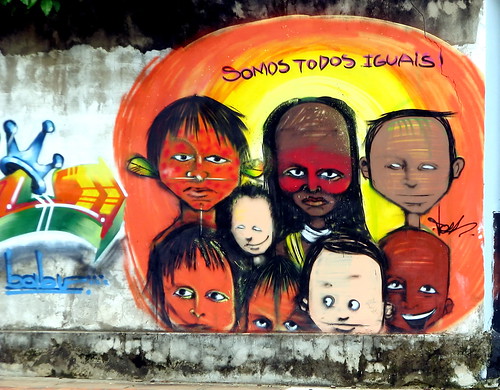
We are all equal.
The advertisements on billboards carried many versions of the themes of globalization and a world of interrelationship. Above one of the playgrounds, a public service announcement tells of the World Day of the struggle against AIDS. The words below the couple kissing say, "One of them has HIV. The other knows." And it continues with, "To live with AIDS is possible – Without prejudice."
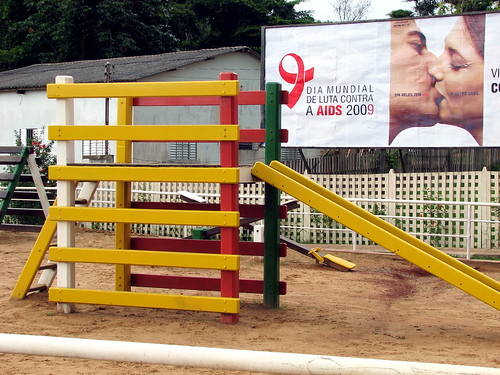
Brazil is known for having one of the most successful anti-AIDS programs in the world which is based in large part on taking a frank and aggressive approach to what needs to be done. One example is the educational campaign about living with AIDS. And there's more. Brazil's threats to violate globally monopolistic patents and manufacture its own anti-HIV medicines has forced down the prices set by the multinational pharmaceutical corporations. And each year the Brazilian government distributes millions and millions of free condoms, especially at Carnival time. Indeed, there is even a rainforest brand of natural latex condoms which are a sustainable product of the Chico Mendes Extractive Reserve in Xapuri.
Development, of course, has many products. Crossing the parkway from the playground, we find an advertisement from NUTRISAL which is one of Brazil's large suppliers of cattle feed. About 80% the cleared Amazon lands are now occupied by cows and Brazil is the world's number one exporter of beef. The sign below says, "Together with the producer helping our State to grow." During the later 20th Century and continuing to present growth has indeed been the major theme as the frontier of the forest has been pushed back, especially for grazing cattle and growing soybeans. Today there are about 25 million people living in Amazônia and by some counts as many or perhaps even a greater number of cows.
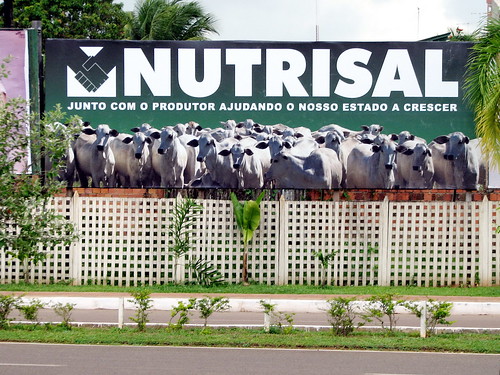
But I was not really prepared for what I found next. My biggest surprise appeared just a few hundred meters down the street at the Marina Silva Library of the Forest. It is now adorned with a new icon – an astronaut!
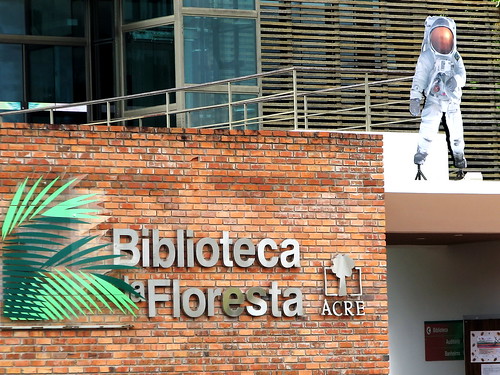
"What in the world is going on here? Can all of this somehow be linked together?" is what I thought and I entered the library to find out.
An entrance foyer has a beautiful set of graphics introducing:
the peoples of the forest;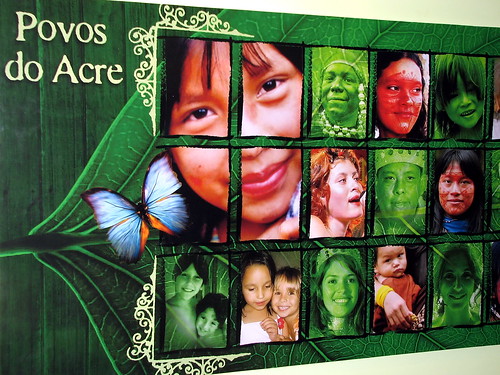
Amazonian biodiversity;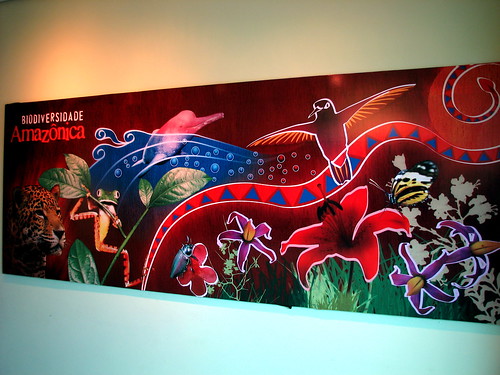
and the credo of the people who live here.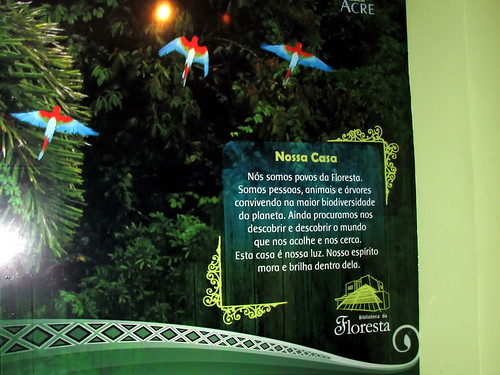
Our Home. We are peoples of the forest. We are persons, animals and trees living with the greatest biodiversity of the planet. We still seek to discover and discover the world that shelters us and surrounds us. This home is our light. Our spirit lives and shines in her.
The main foyer of the library tells the story of the hundred-plus years of globalization of the Amazon Basin. Development began in earnest with the rubber boom that supplied latex to the new motor-driven and steam-engine world of 20th Century industrialization. The wealth bubble that arrived in Brazil was so great that the rubber barons built a European-style Grand Opera House in the central Amazon at Manaus where the legends say that the money flowed so freely that cigars were lit with 100 dollar bills and dirty laundry was sent to Portugal for cleaning.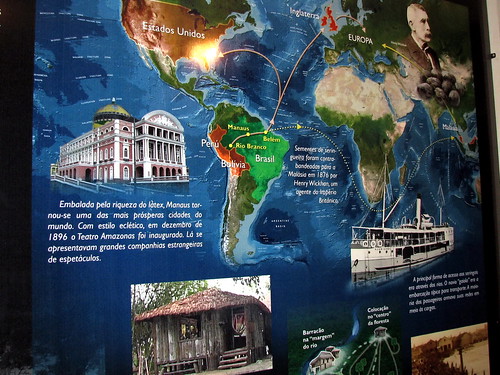
Rio Branco and Acre are located at Brazil's most western extension of the rubber trade.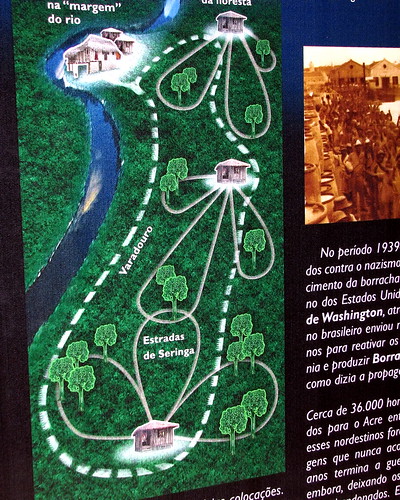
The homes of rubber-tappers were built with a cluster of latex-gathering trails in the forest.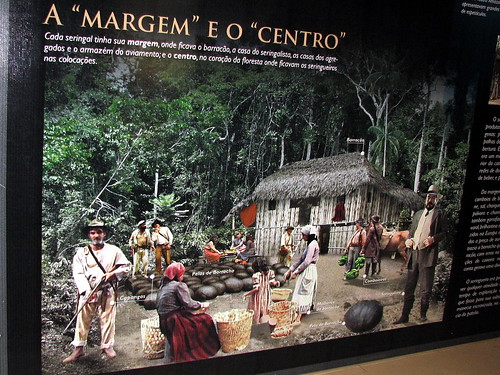
All the trails led to riverine settlements and trading posts, many of which remain to present times as villages and towns along the rivers.
But it all went bust. In one of the world's greatest acts of bio-piracy, seeds secretly taken from the Amazon were used to establish highly efficient and more competitive rubber plantations in the European colonies of Southeast Asia. As the Amazon bubble burst, the vast riverine and forest networks of workers, local bosses and traders were left behind to survive as best they could with a subsistence life of hunting, fishing, farming and gathering from the bounty of nature. In this fashion the serringeiros (rubber-tappers) became a new people of the forest.
The Brazilian rubber trade flourished again briefly during WWII when the Japanese controlled the plantations and sea routes of SE Asia but soon synthetic rubber emerged to largely replace the natural products.
The next great wave of development in the Amazon occurred under Brazil's era of military dictatorship (1964 -1985) when the decision was made to open the vast interior with roads and land grants under the slogan, "A Land without People for A People without Land." The offer of free land to small holders had a noble sound to it, but the greatest beneficiaries of the new access to the forest were logging, ranching and agribusiness interests who were dependent upon the new infrastructure of roads and ports connecting to commodity markets.
Unlike the previous rubber boom which depended on maintaining the forest habitat; this later development model was based on deforestation and dramatically altered the landscape and land uses of the Amazon basin. This set up an inevitable clash with the peoples of the forest that was fought across the last decades of the 20th Century. In Acre this conflict was especially intense (with many killings) and it triggered the Peoples of the Forest Movement in which Chico Mendes figured so prominently.
The infrastructure openning the interior of Brazil for development was a major program under the military dictatorship.

Cows started to replace trees across a vast area.
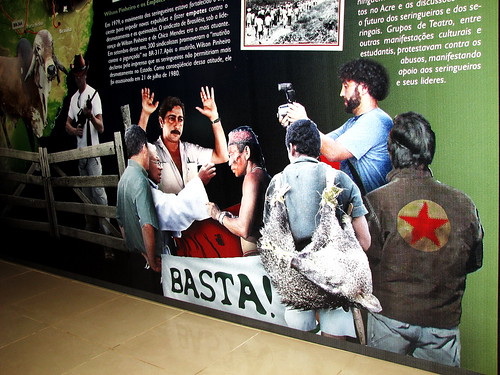
Chico Mendes and his serringeiro comrads countered with the People of the Forest Movement.
Taking on a central leadership role following the assassination of Wilson Pinheiro, Chico organized locally and traveled to the capital of Brasilia and to Washington, DC to forge a new save-the-rainforest alliance with national leaders and international environmental organizations. But it was his assassination on December 22, 1988 that truly galvanized the movement and began to bring results. The story is well-told in "The Burning Season", the widely read English language account written by the NY Times reporter Andrew Revkin.
Today, and for some years now, much has changed in Acre under the more progresive politics of the Workers Party. Indeed, Acre has generated a vision of sustainability offered by internationally known Senator Marina Silva and others. Marina was for 5 years the Federal Minister Environment but recently resigned from the Workers Party in order to promote a more advanced agenda for the 21st Century. She is expected to launch a bid for the Presidency in 2010 under the flag of the Green Party (more about Marina Silva here and here).
The broad result of years of collective effort has been the emergence of large-scale land-use planning and zoning in an effort to find a sustainable balance between nature and various cultural and technological approaches to using the land.
The new map of Acre contains now contains -- in addition to conventional delineations such as urban and agricultural areas -- Conservation Units, Extractive Reserves and Indigenous Lands and there are a host of progressive environmental laws, at least on the books if not always realized on the land. In other words, a grand and noble experiment has been set in motion to see if development in Acre and Amazônia can achieve a sustainable and harmonious future between humans and nature.
Going from these ground-level exhibits to the floors above for more of the story we go up a stairway that has been painted as if the forest floor, suspended with colorful rays of light and butterflies, and decorated with historical photos of from the life of Chico Mendes.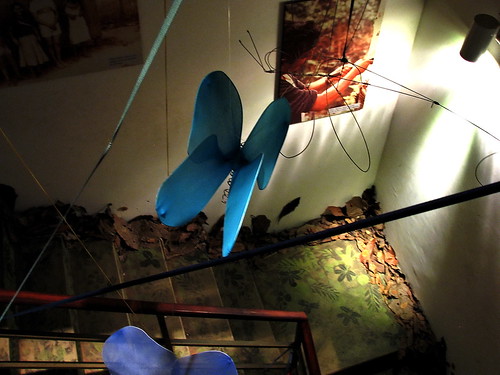
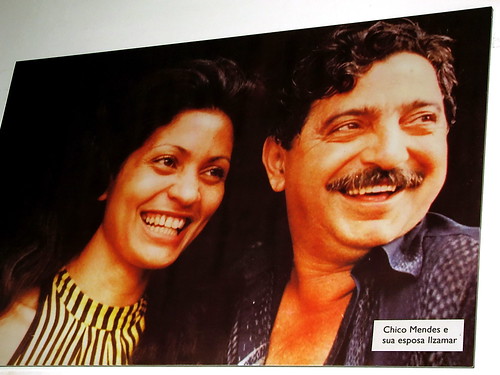
Walking up the stairs through history and butterflies, I imagined Acre as one of the places that the world will be watching, and this library as one the places where the people of the forest will be watching the world. Let's continue with the exhibits to catch a glimpse of how that might be.
On the second floor we find that the library is online and networked. The computers provide Internet access for public use and this is where I often upload posts for the blog. Some computers are even decorated with butterflies. On the computers' home pages the library and the very exhibits that I'm discussing here are online and available to the world.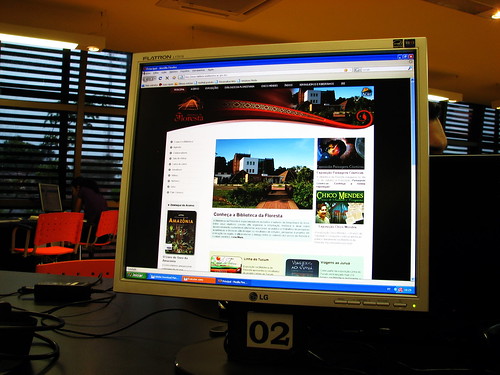
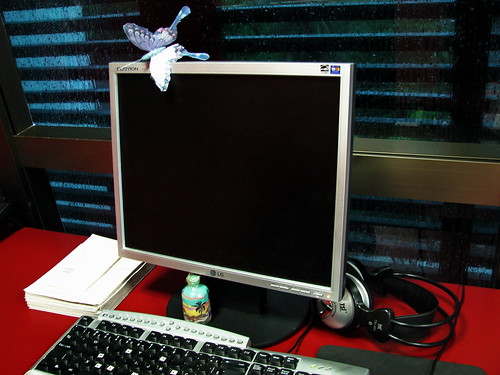
The top floor is presently devoted to archives and several exhibits including:
Displays of the crafts of region's indigenous peoples
And wall art of serringeiro dwellings where one might find a poster of Mestre Irineu.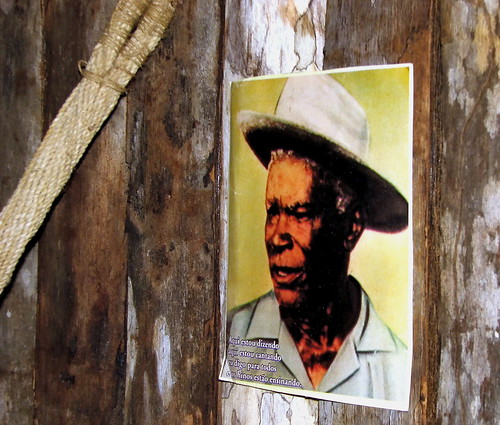
A current special exhibit (which had opened the day before my return to Rio Branco) featured "The Line of Tucum – the Craftworks of Amazônia" and displayed the forest products and activities of the ecological and spiritual community of Ceu do Juruá which is the birthplace of Padrinho Alfredo and one of the first places that I visited in Brazil.
Padrinho Alfredo's book, "Journeys to Juruá" sharing his thoughts and journal notes of several trips to Juruá was featured.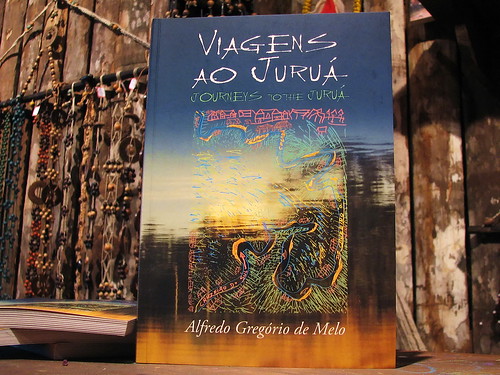
In the exhibition, the sustainable production processes that have been utilized are explained and the products were displayed and for sale. When I had visited the Juruá only six years ago things were just getting started and none of this had been set in place. And now, here it all was at the Library of the Forest.
Congratulations for making a great progress. PARABÉNS e VIVA! Ceu do Juruá.
Ceu do Juruá presents an important experiment seeking to discover forms of sustainable development for forest dependent riverine communities. Its example is now being networked around the world by many foreign visitors and, of course, via the Internet. This ability of the periphery to connect with th center also is a face of contemporary globalization.
Another example this new "information age sharing" appeared just across the salon where a group of young people were gathered, at the edge of the dugout canoe, to make a video of a science project with their cellular phones. And another one was using her mobile to video the display of indigenous artifacts.
At a recent conference on digital ecology that I attended before leaving São Paulo I had learned that soon the cell phone will be able to perform most of the functions of audio-visual equipment and a laptop computer – all hand held and connected to the Internet. This is an important reason that the Brazilian Federal Ministry of Culture has been working so diligently to promote digital inclusion and widespread broadband access, as well as liberal rules for peer-to-peer collaboration and content sharing.
In an interesting reversal of the eco-piracy of the rubber boom, Brazil has launched a free software movement to counter the monopolistic designs of Microsoft and other multinational corporations of the Information Age. Calling it a "peeracy", Brazil has been promoting a "conspiracy of collaboration" that is being supported at the highest governmental levels (watch this speech from "Pirate Lula") These young people in a library in Amazônia, far from the cosmopolitan centers of the great cities, soon will have a chance to be heard and to participate in world-changing processes.
All of which brings me back to the new astronaut icon that now stands over the entrance to the library.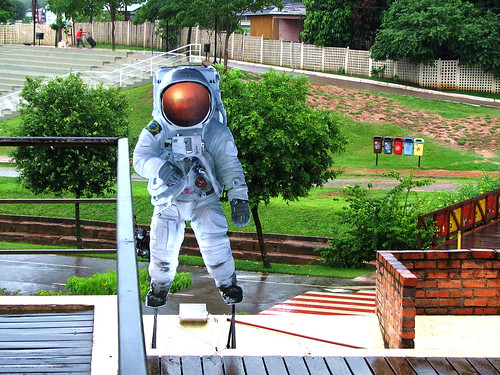
Rio Branco is about to get a planetarium and observatory as part of a new center for instruction in the sciences of astronomy. Here's a slideshow of the library's featured exhibit…
and here's a short video illustrating the spectacular visual presentations that will arrive with the planetarium.
Does all this seem a bit strange for a small city deep in Amazônia? And does it seem even stranger to be the featured exhibit at The Library of the Forest? Why offer access to instruction in astronomical sciences to the "peoples of the forest"? Can we find any sense in this, a plausible "method to the madness?"
Here is a vision that connects -- satellite monitoring is the precise technology capable of saving the Amazon forest.
The great problem of achieving the goals of Federal environmental laws across a forest region the size of Western Europe is that it is very difficult to know what is going on let alone to police and enforce regulations promulgated far away in Brasilia. But in recent years the Ministry of Environment has been working in tandem with the Space Agency to achieve effective satellite monitoring of the forest. Not only has this has become a powerful tool in the fight against illegal logging but it promises to create a measurement system that would serve as the basis for payments to countries that help meet the challenge of global warming by reducing destruction and degradation of their forests. Indeed, this is the single exciting and positive thing now coming out of the talks in Copenhagen.
[UPADATE: 20 December 2009 Forest plan suffers setback at Copenhagen -- REDD is delayed for the next round of talks.]
Deforestation of tropical forests releases more emissions than the world's entire transportation sector of cars, busses and trucks. And Brazil has been one of the world's leading contributors to the problem. One of the technologically most cost-effective means of quickly reducing global carbon emissions is to pay countries like Brazil for preserving the ecosystem services provided by their standing forests. Achieving this depends on two things: first, Brazil and others must show the capacity to actually protect the forests; and, second, the developed world that will benefit greatly from the global reductions of emissions will have to pay for the "lost economic opportunities" of not following the damaging-but-profitable deforestation ways that countries like the US used to promote their own development.
This is the basis for the system known as REDD (Reduduced Emissions from Deforestation and Degradation) and it promises to turn vital ecosystem functions such carbon sequestration that were once thought of as "free services" into highly valued commodities that can have economic standing as do other "commodities." Today, the world buys wood, soybeans and beef from Brazil. It is more than appropriate to include carbon sequestration in the list. Indeed it is a global necessity.
[UPDATE: Mongabay reports that the Moore Foundation is teaming with Google Earth to produce a high powered platform for monitoring the Andes and the Amazon. This is exciting. Read more about it with more backgound here.]
As forest protection is economically "incentivized," Brazil's space agency can provide the tools if there is the political will to use them. Indeed, many interesting developments and possibilities provided by satellite and information age technologies offer the promise of tying it all together into more sustainable configuration of planning, development and enforcement in the Brazil's interior. Thus, the meme "digital ecology" is emerging not only as a cyber jargon for online networking but as a means for creating concrete and more-than-virtual value for on-the-ground places such as forests.
In Brazil, where global warming was barely on the public agenda only a year ago, a new national political debate about sustainable development has emerged along with a growing awareness of global interrelatedness at every level – cultural, economical, ecological and political. Finding the sustainable balance among the many contradictory and opposing forces has already emerged as a major theme of the 2010 presidential election in Brazil and has erupted at Copenhagen.
I have no "crystal ball" to see the future but one thing does seem certain. The pace of change and development is moving faster and faster. Today, the rainbows and satellites are rising above the homes of Rio Branco and across Amazônia.
The 21st Century is about information. And the information is making us aware of our common planetary predicament. It is also giving us unparalled opportunities to participate in creating the future of life on earth. Hopefully, this future will be carried forth by a WE which includes the people who give voice to the places that sustain us all. We have the tools for this. Now, let's see if we can mobilize the political will to use them.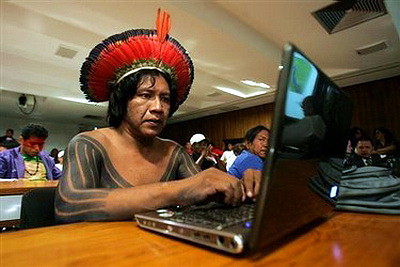

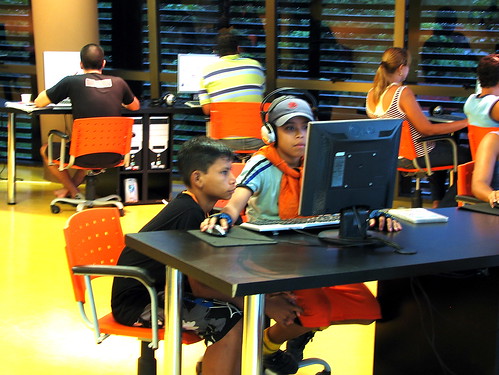





No comments:
Post a Comment